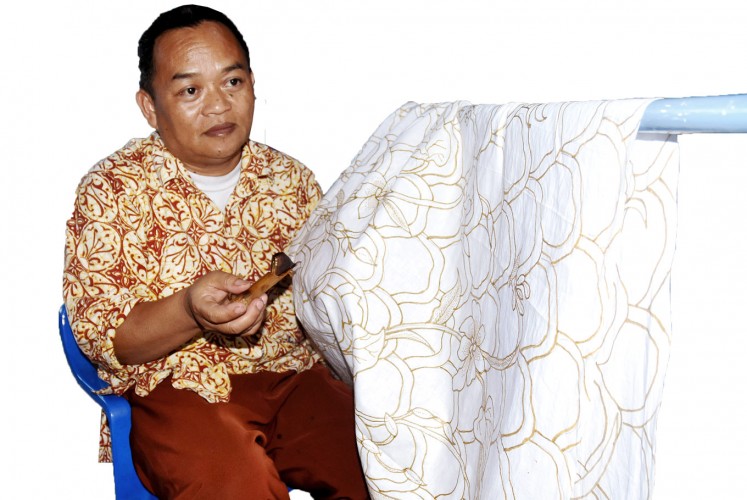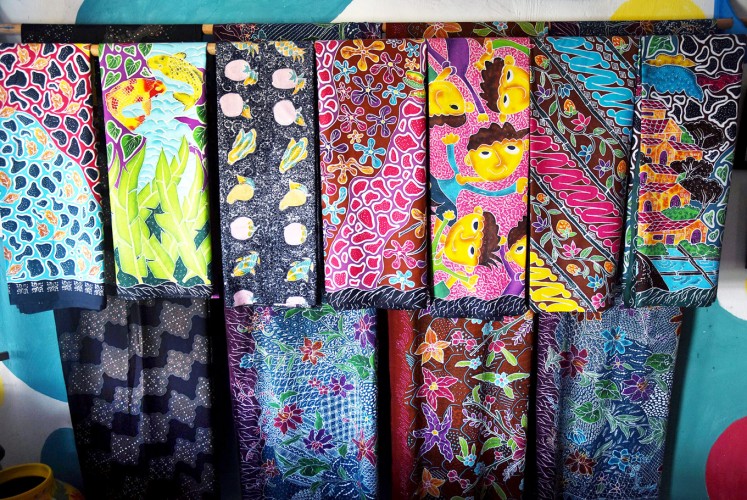Popular Reads
Top Results
Can't find what you're looking for?
View all search resultsPopular Reads
Top Results
Can't find what you're looking for?
View all search resultsSumari Batik treasured in Indonesia and abroad
Change text size
Gift Premium Articles
to Anyone
S
everal workers draw apple-patterned batik designs on white cloth using a canting (spouted copper containers) during a chilly day in Batu, East Java.
They work for home-based batik maker Sumari Batik, which is located on Jl. Raya Ngajum in Pandanrejo village in Batu.
Sumari Batik produces batiks by mixing nature-based and chemical dyes.
Batu is famous for its fruit and vegetables, especially apples and strawberries, and this inspires Sumari Batik owner, Sumari, to adorn his batik with fruits of the city.
His work includes images of apples and strawberries, along with vegetables, kites, children’s faces and animals, including butterflies and Java’s long-tailed monkeys.
“In 1996, I returned home to craft wayang kulit [leather puppets] for wayang shows. As I got used to drawing batik designs on puppets, I began to apply the art to batik cloth,” said the 49-year-old.
To dye the batik, Sumari uses chemicals and organic dyes made from apple and avocado leaves, tea, carrots, papaya and roses.
Batik painted with chemical dyes takes a month to produce, while that using natural dyes needs more than three months, depending on the intricacy of the motif.
The organic method requires the dyeing process to be repeated three times to produce bold colors. On the other hand, the chemical method needs only one dyeing process, and the batik cloths cannot be dried in the sun.
Sumari Batik founder Sumari. (JP/Aman Rochman)While the organic method takes longer, batik cloths produced using this method will also last longer than the chemical-based ones.
“Natural colors make batik cloths last longer and don’t trigger an allergic reaction, particularly in people who are sensitive to chemicals,” Sumari said.
Sumari Batik produces 100 chemical-based batik cloths monthly and 20 organic-based ones every three months.
The products have earned a respectable reputation among batik enthusiasts in Indonesia and in the foreign market since Sumari officially opened Sumari Batik in 2003.
In Indonesia, Sumari sells his Batik to Jakarta, Yogyakarta and Denpasar at a minimum price of Rp 450,000 (US$33.7) for the chemical-based products and Rp1.5 million for each organic-based piece.
As for the foreign market, Sumari has shipped his products to the Netherlands, Japan and France.
“Consumers from the Netherlands like Batik bearing children’s faces in wayang style and Japanese consumers are fond of fruit and plant motifs, which they say are good for their health,” he said.
Sumari hopes to further expand his business, but he is finds it difficult to raise his production capacity as batik makers are rare in Batu, which is a farming region.
In addition, Sumari also finds it too expensive and complicated to obtain patents for the motifs he has invented. Nevertheless, Sumari is not worried about the possibility of his designs being stolen or copied.
“If someone steals or copies my designs, then I’ll just make new ones because my creativity cannot be plagiarized,” he said.













